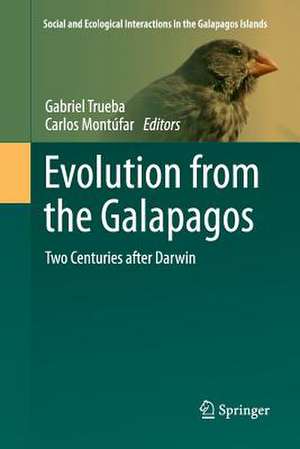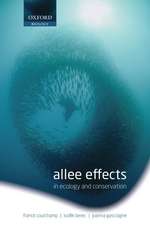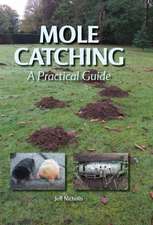Evolution from the Galapagos: Two Centuries after Darwin: Social and Ecological Interactions in the Galapagos Islands, cartea 2
Editat de Gabriel Trueba, Carlos Montúfaren Limba Engleză Paperback – 8 iul 2015
| Toate formatele și edițiile | Preț | Express |
|---|---|---|
| Paperback (1) | 635.15 lei 43-57 zile | |
| Springer – 8 iul 2015 | 635.15 lei 43-57 zile | |
| Hardback (1) | 640.06 lei 43-57 zile | |
| Springer – 4 iun 2013 | 640.06 lei 43-57 zile |
Preț: 635.15 lei
Preț vechi: 747.23 lei
-15% Nou
Puncte Express: 953
Preț estimativ în valută:
121.54€ • 127.21$ • 101.16£
121.54€ • 127.21$ • 101.16£
Carte tipărită la comandă
Livrare economică 31 martie-14 aprilie
Preluare comenzi: 021 569.72.76
Specificații
ISBN-13: 9781489991355
ISBN-10: 1489991352
Pagini: 188
Ilustrații: XVIII, 168 p.
Dimensiuni: 155 x 235 x 10 mm
Greutate: 0.27 kg
Ediția:2013
Editura: Springer
Colecția Springer
Seria Social and Ecological Interactions in the Galapagos Islands
Locul publicării:New York, NY, United States
ISBN-10: 1489991352
Pagini: 188
Ilustrații: XVIII, 168 p.
Dimensiuni: 155 x 235 x 10 mm
Greutate: 0.27 kg
Ediția:2013
Editura: Springer
Colecția Springer
Seria Social and Ecological Interactions in the Galapagos Islands
Locul publicării:New York, NY, United States
Public țintă
Professional/practitionerCuprins
Foreword.- Part I: Historical Perspectives.- Darwin-Wallace paradigm shift: The ten days that failed to shake the world.- From Copernicus to Darwin.- Part II: A Microbial World.- A Vestige of an RNA Apparatus with Ribozyme Capabilities Embedded and Functions within the Modern Ribosome.- Covering all the Bases: the Promise of Genome-Wide Sequence Data for Large Population Samples of Bacteria.- Role of Symbiosis in Evolution.- Part III: Early Eukaryotes.- The Evolutionary Origin of Animals and Fungi.- Written in stone: The fossil record of early eukaryotes.- Endosymbiosis in the origin of eukaryotes.- Symbiogenetics: Proposal for a new science.- Part IV: A Planet of Animals and Plants.- Epochal change: sweltering climate at the Paleocene/Eocene boundary (55 million years ago).- Speciation and evolution of Darwin’s finches.- Ecological Selection and the Evolution of Body Size and Sexual Size Dimorphism in the Galapagos Flightless Cormorant.- Index.
Textul de pe ultima copertă
In 2001 Lynn Margulis visited the main campus of the Universidad San Francisco de Quito to give the commencement address and to travel to the Tiputini Biodiversity Station in the Ecuadorian Amazonia. We felt privileged to be part of her entourage for this trip to the rainforest and to have the opportunity to listen her descriptions of hundreds of plants, fungi, insects, slime molds, and even symbiotic protists inhabiting the guts of primitive termites. During this trip Lynn expressed the need to promote a more comprehensive perspective on biological evolution, one that takes in account not only the classical and modern interpretations of Darwin’s ideas but also the mechanisms of microbial evolution, especially symbiogenesis -the process that gave rise to eucaryotes more than two billion years ago and has continued to shape protists and multicellular organisms ever since. It was clear that evolutionary science was concentrated primarily on macroscopic biota while neglecting microbes almost entirely.
Those conversations became the main motivation to bring some of the most important minds working in evolutionary science to the very place that inspired Charles Darwin, the Galapagos Islands. During the summers of 2005 and 2009 we gathered scientists specializing on plants, animals, bacteria and, protists to discuss the peculiarities of evolutionary mechanisms within each domain of life. This book contains some of the most important lectures presented at the first two World Summits on Evolution.
Those conversations became the main motivation to bring some of the most important minds working in evolutionary science to the very place that inspired Charles Darwin, the Galapagos Islands. During the summers of 2005 and 2009 we gathered scientists specializing on plants, animals, bacteria and, protists to discuss the peculiarities of evolutionary mechanisms within each domain of life. This book contains some of the most important lectures presented at the first two World Summits on Evolution.
Caracteristici
Includes lectures presented at the two international “summits on evolution" from 2005 and 2009 Gives an overview of developments that have taken place in our understanding of evolution since the papers of Darwin and Wallace Demonstrates a path for future research which will further our understanding of life on earth and how it evolved Includes supplementary material: sn.pub/extras


























